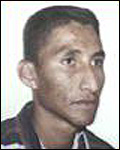
Los Zetas is a Mexican criminal syndicate and terrorist organization, known as one of the most dangerous of Mexico's drug cartels. They are known for engaging in brutally violent "shock and awe" tactics such as beheadings, torture, and indiscriminate murder. While primarily concerned with drug trafficking, the organization also runs profitable sex and gun rackets. Los Zetas also operate through protection rackets, assassinations, extortion, kidnappings and other illegal activities. The organization is based in Nuevo Laredo, Tamaulipas, directly across the border from Laredo, Texas. The origins of Los Zetas date back to the late 1990s, when commandos of the Mexican Army deserted their ranks and began working as the enforcement arm of the Gulf Cartel. In February 2010, Los Zetas broke away and formed their own criminal organization, rivalling the Gulf Cartel.

The Gulf Cartel is a criminal syndicate and drug trafficking organization in Mexico, and perhaps one of the oldest organized crime groups in the country. It is currently based in Matamoros, Tamaulipas, directly across the U.S. border from Brownsville, Texas.
The timeline of some of the most relevant events in the Mexican drug war is set out below. Although violence between drug cartels had been occurring for three decades, the Mexican government held a generally passive stance regarding cartel violence through the 1980s and early 2000s.

Miguel Ángel Treviño Morales, commonly referred to by his alias Z-40, is a Mexican former drug lord and leader of the criminal organization known as Los Zetas. Considered a violent, resentful and dangerous criminal, he was one of Mexico's most-wanted drug lords until his arrest in July 2013.
The 2010 San Fernando massacre, also known as the first massacre of San Fernando, was the mass murder of 72 undocumented immigrants by Los Zetas drug cartel in the village of El Huizachal in the municipality of San Fernando, Tamaulipas, Mexico. The 72 killed—58 men and 14 women—were mainly from Central and South America, and they were shot in the back of the head and then piled up together. The bodies were found inside a ranch on 24 August 2010 by the Mexican military after they engaged in an armed confrontation with members of a drug cartel. They received information of the place after an Ecuadorian survived a shot to the neck and face, faked his death, and then made his way out of the ranch and up to a military checkout to ask for help. There were only three survivors. Investigators later mentioned that the massacre was a result of the immigrants' refusal to work for Los Zetas, or to provide money for their release.

Mario Armando Ramírez Treviño, commonly referred to by his aliases El Pelón and/or X-20, is a Mexican suspected drug lord and former leader of the Gulf Cartel, a drug trafficking organization.

The Apodaca prison riot occurred on 19 February 2012 at a prison in Apodaca, Nuevo León, Mexico. Mexico City officials stated that at least 44 people were killed, with another twelve injured. The Blog del Narco, a blog that documents events and people of the Mexican Drug War anonymously, reported that the actual (unofficial) death toll may be more than 70 people. The fight was between Los Zetas and the Gulf Cartel, two drug cartels that operate in northeastern Mexico. The governor of Nuevo León, Rodrigo Medina, mentioned on 20 February 2012 that 30 inmates escaped from the prison during the riot. Four days later, however, the new figures of the fugitives went down to 29. On 16 March 2012, the Attorney General's Office of Nuevo León confirmed that 37 prisoners had actually escaped on the day of the massacre. One of the fugitives, Óscar Manuel Bernal alias La Araña, is considered by the Mexican authorities to be "extremely dangerous," and is believed to be the leader of Los Zetas in the municipality of Monterrey. Some other fugitives were also leaders in the organization.
The 2012 Nuevo Laredo massacres were a series of mass murder attacks between the allied Sinaloa Cartel and Gulf Cartel against Los Zetas in the border city of Nuevo Laredo, Tamaulipas, across the U.S.-Mexico border from Laredo, Texas. The drug-violence in Nuevo Laredo began back in 2003, when the city was controlled by the Gulf Cartel. Most media reports that write about the Mexican Drug War, however, point to 2006 as the start of the drug war. That year is a convenient historical marker because that's when Felipe Calderón took office and carried out an aggressive approach against the cartels. But authors like Ioan Grillo and Sylvia Longmire note that Mexico's drug war actually began at the end of Vicente Fox's administration in 2004, when the first major battle took place in Nuevo Laredo between the Sinaloa Cartel and Los Zetas, who at that time worked as the armed wing of the Gulf Cartel.

Dolores Guadalupe García Escamilla was a Mexican crime reporter and anchorwoman for Punto Rojo, a radio show on XHNOE-FM radio based in Nuevo Laredo, Tamaulipas, Mexico. She had experience in a number of news platforms and was a radio personality and crime reporter since 2001.
Narcoculture in Mexico is a subculture that has grown as a result of the strong presence of the various drug cartels throughout Mexico. In the same way that other subcultures around the world that are related to crime and drug use, Mexican narco culture has developed its own form of dress, music, literature, film, religious beliefs and practices and language (slang) that has helped it become a part of the mainstream culture in some areas of the country, mainly among lower-class, uneducated youth. Narco culture is dynamic in that there are various regional differences within Mexico and among those who participate in it.

Héctor Manuel Sauceda Gamboa, commonly referred to by his alias El Karis, was a Mexican suspected drug trafficker and high-ranking leader of the Gulf Cartel, a drug trafficking organization based in Tamaulipas. He was the brother of the drug lord Gregorio Sauceda Gamboa, another high-ranking drug trafficker who worked under the tutelage of Osiel Cárdenas Guillén, the former top leader of the cartel. El Karis took the lead of the Gulf Cartel in Reynosa following the arrest of Jaime González Durán, a leader of Los Zetas drug cartel, in November 2008.

On 3 November 2013, Catholic priest Carlos Ornelas Puga was kidnapped by gunmen in the Mexican state of Tamaulipas. His whereabouts remain unknown and the motives behind his kidnapping are unclear, but the Mexican authorities allege that the priest was kidnapped by an organized crime group.

Joselyn Alejandra Niño, commonly referred to by her alias La Flaca, was a Mexican suspected assassin of the Gulf Cartel, a criminal group based in Tamaulipas, Mexico. She gained popularity on social media on 5 January 2015, when an anonymous person uploaded a picture of her posing with a firearm in an organized crime leak page. The post identified her as a Gulf Cartel member based out of Río Bravo. As a foot soldier, she was responsible for fighting off cells of Los Metros, a rival faction of Los Ciclones, a Gulf Cartel subgroup she belonged to.

Gilberto García Mena, also known as El June, is a Mexican convicted drug lord and former high-ranking member of the Gulf Cartel, a criminal group based in Tamaulipas, Mexico. He began his criminal career as a small-time marijuana smuggler in his teens, and later joined the Gulf Cartel under kingpin Juan García Ábrego. García Mena was arrested by U.S. authorities in Texas while possessing marijuana in 1984, but was released without a conviction. He returned to Mexico, and established a center of operations in Nuevo León. García Mena was arrested on drug-trafficking charges in 1989, but authorities were again unable to convict him. Released in 1990, he rejoined the Gulf Cartel.

Víctor Manuel Vázquez Mireles is a Mexican drug lord and high-ranking member of the Gulf Cartel, a criminal group based in Tamaulipas, Mexico. Vázquez Mireles joined the cartel during the 1990s and was a trusted enforcer of former kingpin Osiel Cárdenas Guillén. He started his career in the cartel as one of his bodyguards and was eventually placed in charge of operations in Tamaulipas and Veracruz. He was reportedly responsible for supervising the purchase of drugs intended to be smuggled into the U.S. for distribution and for arranging the assistance of corrupt law enforcement officials in the cartel's operations.

Zeferino Peña Cuéllar, also known as Don Zefe, is a Mexican suspected drug lord and high-ranking member of the Gulf Cartel, a criminal group based in Tamaulipas, Mexico. He was part of the cartel during the 1990s, and was a trusted enforcer of former kingpins Gilberto García Mena and Osiel Cárdenas Guillén. From 1999 to 2001, he served as the municipal police chief of Miguel Alemán. Peña Cuéllar reportedly relied on corrupt Mexican military officials to run drug trafficking activities in Tamaulipas. This group of military officers would later become the foundation for the creation of Los Zetas, the Gulf Cartel's former paramilitary group originally made up of ex-soldiers. In the cartel, he headed organized crime operations in the municipalities of Gustavo Díaz Ordaz, Camargo, Miguel Alemán, Mier, and Guerrero.

Raúl Alberto Trejo Benavides was a Mexican suspected drug lord and high-ranking member of Los Zetas, a criminal group based in Tamaulipas, Mexico. Trejo Benavides served in the Mexican Army from 1991 to 1999, and was a member of the Grupo Aeromóvil de Fuerzas Especiales (GAFE), the army's special forces. He joined the Gulf Cartel under kingpin Osiel Cárdenas Guillén after leaving the army, becoming one of the first members of its newly formed paramilitary wing, Los Zetas. Like Trejo Benavides, most of the first members of Los Zetas were ex-military. Los Zetas was responsible for providing security services to Cárdenas Guillén and carrying out executions on the cartel's behalf.

Jorge López Pérez, also known as El Chuta, is a Mexican suspected drug lord and high-ranking member of Los Zetas, a criminal group based in Tamaulipas, Mexico. López Pérez joined the Mexican Army in 1979. He specialized in martial arts, parachuting, explosives and guerrilla warfare tactics. In 1981, he deserted from the military and joined a cell of the Juárez Cartel, where he coordinated drug trafficking operations in Cancún. In the early 2000s, López Pérez left and worked as an independent trafficker before joining the Gulf Cartel. He became one of the first members of the cartel's newly formed paramilitary wing, Los Zetas. Like López Pérez, most of the first members of Los Zetas were ex-military. Wanted on drug trafficking charges, he is one of the last remaining fugitives from the early Zetas generation.

Luis Alberto Guerrero Reyes was a Mexican suspected drug lord and high-ranking member of Los Zetas, a criminal group based in Tamaulipas, Mexico. He joined the Mexican Army in 1987, specializing in explosives, martial arts and grenade launchers. In 1999, he deserted the military and joined the Gulf Cartel under kingpin Osiel Cárdenas Guillén, becoming one of the first members of its newly formed paramilitary wing, Los Zetas. Like Guerrero Reyes, most of the first members of Los Zetas were ex-military. Los Zetas was responsible for providing security services to Cárdenas Guillén and carrying out executions on the cartel's behalf.

Omar Lorméndez Pitalúa is a Mexican suspected drug lord and high-ranking member of Los Zetas, a criminal group based in Tamaulipas, Mexico. He joined the Mexican Army in 1991 and deserted in 1999. He then joined the Gulf Cartel under kingpin Osiel Cárdenas Guillén, becoming one of the first members of its newly formed paramilitary wing, Los Zetas. Like Lorméndez Pitalúa, most of the original members of Los Zetas were ex-military. Los Zetas was responsible for providing security services to Cárdenas Guillén and carrying out executions on the cartel's behalf. In 2001, Lorméndez Pitalúa worked on assignments for Los Zetas and was responsible for ensuring that smugglers paid taxes to the Gulf Cartel and operated under their supervision in Matamoros.












